Harrold Primary School
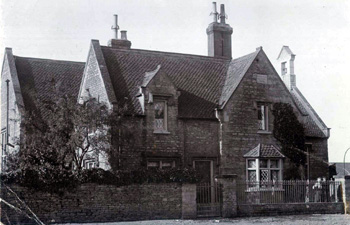
The School House about 1900 [ref: Z1306/54]
National Schools
The national enquiry of 1846/7 was made by the Church of England concerning all its church schools. This was against the background of a new Whig government which championed secular education and the increasing importance of nonconformists, particularly Wesleyan Methodist, and Roman Catholics in providing schools. Harrold reported that the Sunday School contained 35 boys and 69 girls, whilst the daily school had 78 boys; an evening Sunday School contained 11 boys. The return concluded: "The schools have only lately been built". Indeed, an advertisement for tenders for building the new National School was only inserted in newspapers in August 1846, with the deed of gift for the site of the school being signed the following year [ref: EV21/1], when a certificate was issued stating that the school was in union with the National Society [ref: P33/29/1].
The National Schools, one each for mixed juniors and infants, were not officially opened until 20th November 1849 although the date 1847, when the building was finished and the schools came into union with the National Society is the likely date when they first opened their doors. Shortly after this, in 1859 it was decided that the schools were too small and needed to be expanded. More land was conveyed in that year [ref: EV21/2] and by 1863 a new schoolroom had been built [ref: X377/39]
The first Education Act was passed in 1870 (more correctly it was known as the Elementary Education Act). It was a milestone in the provision of education in Britain demonstrating central government's unequivocal support for education of all classes across the country. It also sought to secularise education by allowing the creation of School Boards. These were groups of representatives, elected by the local ratepayers and the Board had the powers to raise funds to form a local rate to support local education, build and run schools, pay the fees of the poorest children, make local school attendance compulsory between the ages of 5 and 13 and could even support local church schools, though in practice they replaced them, turning them into Board run schools (known as Board Schools). Naturally, and luckily for local historians, the Act required a questionnaire of local schools in 1870. Harrold reported a "Church of England School" with accommodation for 172 boys and girls and 42 infants. Harrold was never a Board School.
The school log books give an insight into what life was like for children at the National Schools. All the following references are from SD Harrold 1/1.
The logbooks show the range of subjects being taught in a village school. The master would have been most involved in teaching the top class while the lower classes would have been taught by assistants. These extracts are from1864:
- June 21st: "One of the 1st class boys set to work at Latin and another at book-keeping";
- October 11th: "Gave a lesson in Geography, the towns of France to the 1st class";
- December 1st: "Henry III’s reign to 1st class";
- December 21st: "Grammar – the conjunctions".
Nearly 40 years later, the entry for March 20th 1901 gives the planned curriculum for each class for the following year. The lessons included History topics, elementary science, arithmetic, signing, physical exercise, drawing, reading and writing.
Life was not all work for children in Harrold and the school day could be flexible to allow for some treats:
- May 10th 1864: "Gave the children a half holiday on account of it being Harrold Fair";
- January 9th 1900: "As the fox hounds met on the Green at 11:15 am the children did not go out to play until that hour. The lesson which under ordinary circumstances would have taken place from 11 to 11:30 was taken from 10:45 to 11:15";
- January 9th 1901: "School closed at 4 o’clock in order to allow children to get on the ice in day light".
However, there were also punishments for bad behaviour, for example this early example of the hoodie problem - December 22nd 1864: "Kept a boy for one hour. He had his cap on his head in school".
Conditions could also be poor; the school log book records that on 27 October 1863 the school room was so cold the children were almost unable to write on paper. On November 2nd they got a new stove and lit it, but it smoked out the room and gave out no heat. When the weather was very cold they had no alternative but to light the stove, but it was so smoky they then had to open the windows! By February some of the boys were away with colds they’d caught by having to sit by an open window.
There was also tension over the affiliation of the school to the Church of England. This was because many villagers were nonconformists, the Congregational chapel being very strong. This led to friction between parents and teachers - 17th February 1864: "Several of the dissenters refused to go to church on account of scruples of conscience".
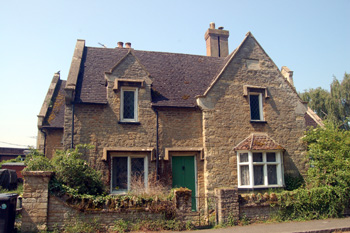
The Old School House, May 2008
The Bedfordshire Mercury of 22nd October 1881 relates a bizarre occurrence at the school: “While getting in the coals a short time ago for the winter’s consumption at the schools, the Carmen noticed a curious hole in a large lump, which on examination proved to be gunpowder, probably put there for blasting and not fired. He called the attention of the schoolmaster to it, remarking that it was a good thing he had found it, as, if it had been unnoticed and put upon the fire with the coal, the consequences might have been most serious”. He was, no doubt, roundly cursed by all the children of the village.
Using various directories held by Bedfordshire Archives it is possible to obtain a rough list of some of the headteachers and Infants mistresses before the school was taken over by the newly formed Local Education Authority:
Headteachers:
- 1853-1854: John Payne;
- 1864: C.H.Lund;
- 1869-1898: Henry Marchant
Infants Mistresses:
- 1853-1854: Elizabeth Beattie;
- 1861-1862: Ann Worth;
- 1864: Martha Thew;
- 1869: Ellen Marchant and Charlotte Darlow;
- 1877-1890: Ellen or Helen Marchant;
- 1894-1898: M.J.Ballance
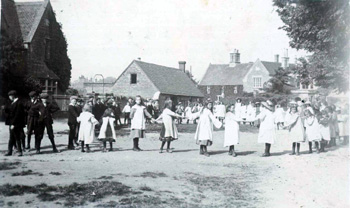
Schoolchildren in 1907 [ref: Z1306/54]
Public Elementary Schools
A land-mark Education Act was passed in 1902, coming into effect in 1903. It disbanded the School Boards and gave day to day running of education to newly formed Local Education Authorities, usually the county council, as in Bedfordshire. The old Board Schools thus became Council Schools whilst the old National, British and other non-Board schools became known as Public Elementary Schools. Harrold, as a former National School, became a Public Elementary School
Bedfordshire Archives has a scrapbook of cuttings of visits made to most Bedfordshire Schools by School Inspectors for a period from just before the First World War through the inter-war years [ref: E/IN1/1].
The first recorded visit was in February 1911 to the Infants Department when average attendance was 38 and the inspector noted: "This small school is taught with much sympathy, skill and success. The little ones are happy, the work is well varied and the level of efficiency reached is very creditable to the conscientious, hard-working mistress". The next visit was not until 1922 when it was recorded: "This is a thoroughly well taught little School with a particularly pleasing atmosphere. Good progress is made from the beginning and the children never look back. The Head Teacher deserves special praise for her work". After this the reports on the infants were included with the rest of the school.
The first visit to the Mixed Department recorded in the book was made on 3rd February 1913 (average attendance for the whole school, including infants, 88). The inspector noted: "The School is in satisfactory order and the work is, on the whole, creditable in character", he found that a better standard could be attained in some of the written exercises and the reading, particularly that of the boys, could be improved; he also felt that more attention should be paid to P.E. A year later the inspector found the 77 children in the mixed department had produced: "a very good year's work" and that the school was steadily improving; "handwriting, needlework, composition and written exercises generally deserve special commendation", obviously the previous year's criticisms had been studied and the situation remedied. The work was all the more praiseworthy due to the large amount of sickness over the year amongst the staff.
The next inspection was not until 1922, when average attendance was 65 when the inspector reported: "In this Department Reading, Writing and Composition are satisfactory, and Arithmetic in Class I is fairly good. Geography appears to have been carefully taught, though not all the children have profitted [sic] adequately by the Teaching. History is weak. Singing, considering there is no piano, is satisfactory on the whole. Drawing has made progress of late, but leaves room for further improvement. Order is good".
Two years later a special visit was made at the request of the Local Education Authority (Bedfordshire County Council) when results were found to be "very well up to average" in reading, writing, spelling and arithmetic, for the rest there had not been much change since the last visit although singing had "somewhat deteriorated". The inspector noted: "The children are quite well behaved in School". The sting was in the tail: "The point which calls for the most serious criticism is the age classification of the lower group - Standards I-III - where the majority of children are too old, some of them two and even three years too old, for the Standard in which they are placed".
The next recorded visit to the mixed department in the book occurred early in 1927, again by special request of the Local Education Authority, when 57 children were on the roll. In modern language the there was evidence of the place being a failing school. The problem of children being held back persisted as only six were in the standard in which they should normally have been placed. "Organisation is thus evidently at fault. Routine work also requires reconsideration in several respects: there is, except in Arithmetic, no differentiation of the work in any grouping in the Senior Department: no provision is made to enable the older or better scholars to study or make notes for themselves in such subjects as History and Geography: there is no scheme for Science of observation lessons. Supervision of the exercise books leaves something to be desired, especially in written English as many exercises are left uncorrected. There has been little change in outlook since the Time Table and schemes were formulated, some fourteen years ago, and no entries in the Punishment Book have been made since 1915. Though discipline is not bad, there is some lack of steadiness at times: as training in private study with its attendant self-reliance is practically non-existent, this is not altogether surprising". Further on the inspector noted: "it may be said that many of the text-books possessed by the school are completely out of date". Not all was gloomy: "The work however, in exercise books and in examination papers, is creditably neat and Handwriting is good".
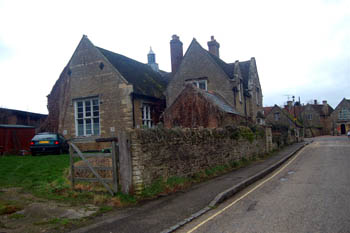
The older Harrold School buildings from the side, January 2008
The infants were in a slightly better state, but even here not all was rosy: "The Infants are making satisfactory progress, though the room is congested and the teacher has too much to do. Their Reading and Writing are very creditable: their varied occupations arouse much interest, and their behaviour is good. Probably it would be advantageous to keep to print script in this division. Retardation, however, begins in this room and should be remedied at once"
The buildings were not wonderful either, a visit in 1925 notes: "The offices [toilets] are too close to the School and those provided for each sex have four seats in one compartment: the wall between the girls' offices and the coal shed is bulging into the offices and is loose: the urinal drain is blocked. The cloakrooms are inadequate and ill-arranged: the playground surface is very bad: the roof and guttering want cleaning: some damp penetrates. The chimney of the stove appears to be breaking away above the strut from the roof. There is much dry rot in window frames and the old lead of the diamond panes is giving way: the ceiling is much cracked and there are occasional falls of plaster. The heating is not satisfactory and the stove smokes in the classroom".
A follow-up visit at the year end of 1927 notes that average attendance had risen to 93 and the inspector noted: "a good detail has been done to remedy the weakness to which attention was directed. A good supply of text books in History and Geography has been provided. The classes are now satisfactorily organised and backward children are in classes more appropriate to their age".
The next visit came in 1930 when average attendance over the whole school was 100; a roll 27 infants was in a separate building with 90 older children taught by the Head Master and an uncertificated mistress "staffing is not generous. Since the Head Master's wife retired from the charge of the Infants' section, several teachers have had it in hand. The present teacher was seen in her second week here. Absences of teachers through sickness for lengthy periods have had their effect on the work. In spite of these drawbacks there has been decided improvement in the last few years, and there is not now that lethargy which was so apparent in the top class two years ago".
A visit in 1934 noted that the buildings were condemned and were to be replaced. Under-staffing had continued, the Head Master teaching 43, with a backward section and a certificated teacher had 54, the lowest level of juniors had to occupy the same room as the infants and the total number on the roll was now 136 with average attendance of 123. "The Certificated Teacher has a very backward group, owing to frequent changes in the teachers of these children, and is not a strong disciplinarian. Below the top class, there are too few desks, many of which are far too small for the children who occupy them, and many have no backs and are of a bad type". Overall "The Head Master in these circumstances is much to be congratulated on the improvement he has made in the work and sport of his own group; the second group have not lost ground but they are decidedly behind the normal level; the Infants' Teacher whose physique is not strong has done sterling work with such a large class, in such desks, and in such a building"
The final visit in the volume occurred in 1936 and early 1937 when average attendance was 109. The inspector noted that: "work has continued in the same premises, and in much of the same unhygienic furniture, which it then, three years ago, was stated should have been scrapped at once as the new furniture could be used for the new School which is now practically completed". During four successive visits from 4th June 1936 to 11th February 1937 "practically never has the same Staff been in charge in successive visits. Only the Head and the Infants' Teachers have remained constant; and the excellent start given by the Infants' Teacher has rendered it possible for the Head Teacher to make good many of the deficiencies, which came about in the intervening classes: indeed his work has been of very exceptional value. The general state of the school at the moment is creditable".
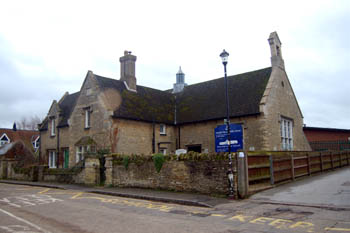
The older Harrold School buildings, January 2008
Harrold Junior Council School
New junior school was officially opened on Monday 31st May 1937 by Robert Skinnet JP, High Sheriff of Bedfordshire at 3 p.m. and the old school premises ceased to be used. At that date Miss M.Coleman was headmistress with Miss N.B.Negus as her assistant. The new junior school was now under the direct control of the Local Education Authority and so was named Harrold Junior Council School; it remained as such for just nine years.
Harrold County Primary School
The third of the great Education Acts was that of 1944 which established the principle of County Primary Schools for children up to the age of 11, at which time they took an examination to determine the nature of the secondary school they would attend until they were 15, the most academically able going to grammar schools, the rest to secondary or secondary modern schools. Harrold Junior Council School became Harrold County Primary School in 1946.
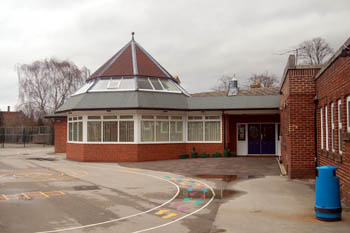
Harrold Lower School, January 2008
Harrold Lower School
In the 1970s Bedfordshire County Council introduced comprehensive education, doing away with the 11+ examination and grammar schools and introducing a tier of school between the old County Primary and County Secondary Schools. Thus Lower Schools now taught children aged 4 to 9, Middle Schools from 9 to 13 and Upper Schools from 13 onwards. Harrold County Primary School thus became Harrold Lower School.